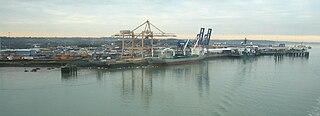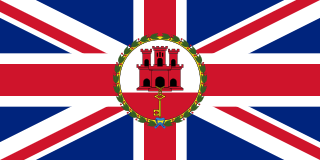
The Home Fleet was a fleet of the Royal Navy that operated from the United Kingdom's territorial waters from 1902 with intervals until 1967. In 1967, it was merged with the Mediterranean Fleet creating the new Western Fleet.

The British Mediterranean Fleet, also known as the Mediterranean Station, was a formation of the Royal Navy. The Fleet was one of the most prestigious commands in the navy for the majority of its history, defending the vital sea link between the United Kingdom and the majority of the British Empire in the Eastern Hemisphere. The first Commander-in-Chief for the Mediterranean Fleet was the appointment of General at Sea Robert Blake in September 1654. The Fleet was in existence until 1967.

The Commander-in-Chief Fleet (CINCFLEET) was the admiral responsible for the operations of the ships, submarines and aircraft of the British Royal Navy from 1971 until April 2012. The post was subordinate to the First Sea Lord, the professional head of the Naval Service. In its last years, as the Navy shrank, more administrative responsibilities were added.

Admiral Sir Harold Martin Burrough was a senior Royal Navy officer and Assistant Chief of Naval Staff to the Royal Navy during World War II.

British Forces Gibraltar is the British Armed Forces stationed in the British overseas territory of Gibraltar. Gibraltar is used primarily as a training area, thanks to its good climate and rocky terrain, and as a stopover for aircraft and ships en route to and from deployments East of Suez or in Africa.

Admiral of the Fleet Sir Varyl Cargill Begg, was a Royal Navy officer. He fought in the Second World War as gunnery officer in a cruiser taking part in the North Atlantic convoys, the Norwegian campaign and the occupation of Iceland and then as gunnery officer in a battleship operating in the Mediterranean Fleet during the Battle of Cape Matapan. After that he commanded a destroyer during the Korean War and was Commander-in-Chief of Far East Command during the Indonesia–Malaysia confrontation. He was First Sea Lord and Chief of the Naval Staff in the late 1960s. In that role he vehemently opposed plans to introduce large new aircraft carriers and instead managed to persuade the British Government to develop the design for three small "through-deck cruisers".

Admiral of the Fleet Sir Algernon Usborne Willis was a Royal Navy officer. He served in the First World War and saw action at the Battle of Jutland in May 1916. He also served in the Second World War as Commander-in-Chief, South Atlantic in which capacity he led actions against German and Japanese raiding ships. He continued his war service as Flag Officer commanding 3rd Battle Squadron and Second in command of the Eastern Fleet and then as Flag Officer commanding Force H, the force which covered North African Operations, the Allied invasion of Sicily in July 1943 and then the Allied invasion of Italy in September 1943. He spent the final years of the war as Commander-in-Chief, Levant, in which capacity he conducted naval operations in support of the Dodecanese Campaign, and then as Second Sea Lord, in which capacity he arranged the manpower for the campaign in the Pacific Ocean against the Imperial Japanese Navy. After the war he served as Commander-in-Chief, Mediterranean Fleet, in which role he was faced with unrest in Mandatory Palestine, before he became Commander-in-Chief, Portsmouth.

HMS Badger was a shore establishment of the Royal Navy on the east coast of the United Kingdom. She was commissioned on 13 September 1939 was the flagship of the headquarters of the Flag Officer in Charge (FOIC), Harwich who was responsible to Commander-in-Chief, The Nore, and was decommissioned on 21 October 1946, although the Operations Room remained as the Emergency Port Control for the Harwich area. The site was Parkeston Quay, now Harwich International Port, and the bunker lies under Hamilton House, currently an occupational health centre, close to the entrance to Harwich International Port, a few miles west of Harwich.

Admiral Sir Hugo Moresby White, was a senior officer of the Royal Navy and subsequently Governor of Gibraltar.
Admiral Sir Sidney Julius Meyrick KCB was a Royal Navy officer who went on to be Commander-in-Chief, America and West Indies Station.
Vice Admiral Sir Nicholas John Hill-Norton, is a retired senior Royal Navy officer who served as Deputy Chief of the Defence Staff (Commitments) from 1992 to 1995.

Admiral Sir George Frederick Basset Edward-Collins was a British senior officer in the Royal Navy during the first half of the twentieth century.

Commodore Submarine Service is a post in the Royal Navy which involves command of the Royal Navy Submarine Service. It evolved from the post of Inspecting Captain of Submarines in 1901 and would later evolve to become the post of Flag Officer Submarines in 1944.
The Admiral Commanding, Orkneys and Shetlands was an operational commander of the Royal Navy. He was charged with the administration of the Orkney and Shetland Islands and operating and defending the fleet base at Scapa Flow that was the main anchorage for both the Home Fleet and Grand Fleet at various times.
The Commander in Chief, Dover was an operational commander of the Royal Navy. His subordinate units, establishments, and staff were sometimes informally known as the Dover Command.

The Rear-Admiral, Alexandria was an administrative shore based appointment of the British Royal Navy. The post was established during the Second World War, subordinate to the Commander-in-Chief, Mediterranean Fleet then later the Commander-in-Chief, Levant.
The Flag Officer-in-Charge, Humber was a Royal Navy officer who administered naval forces located at Immingham and Grimsby, Lincolnshire, England. His formation was sometimes known as the Humber Station or Humber Area. In World War I it was a sub-command of the Admiral of Patrols from 1914 to 1916, then came under the Commander-in-Chief at the Nore until 1921. In World War II the FOIC was responsible to the Commander-in-Chief, The Nore.
The British 13th Destroyer Flotilla, or Thirteenth Destroyer Flotilla, was a naval formation of the Royal Navy from November 1915 – November 1918 and again from September 1939 to January 1944.









